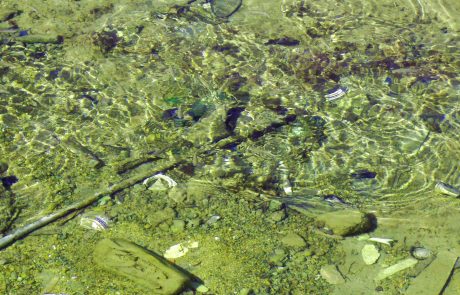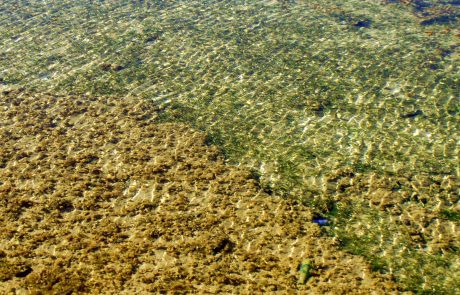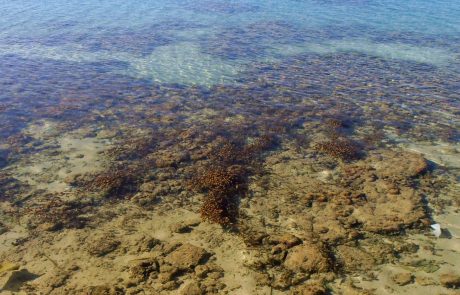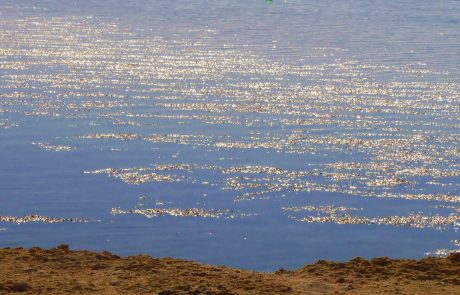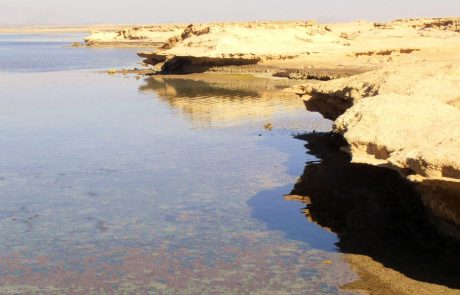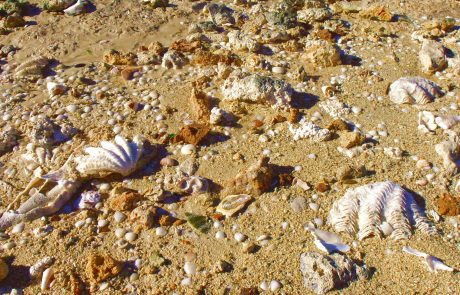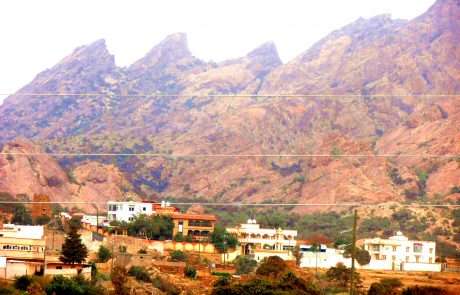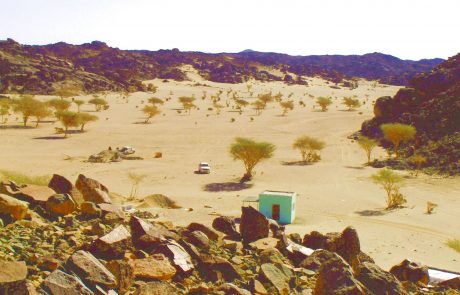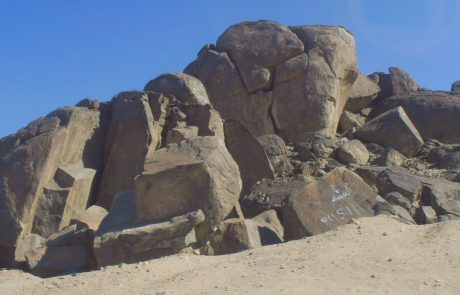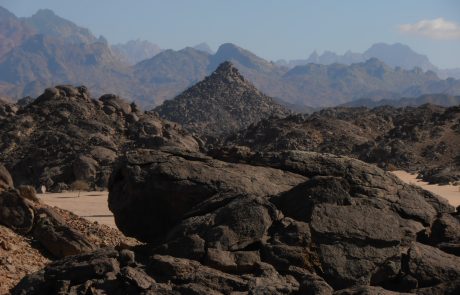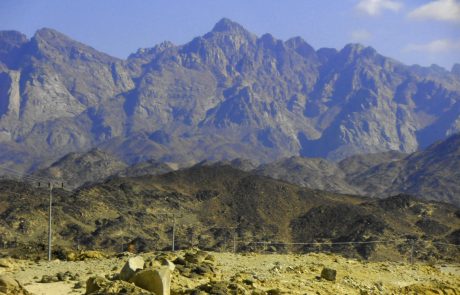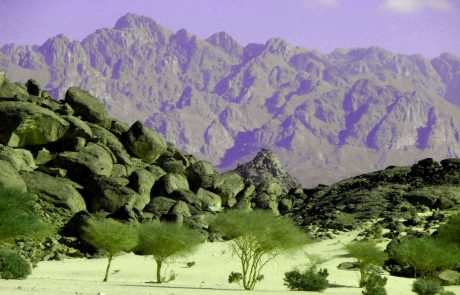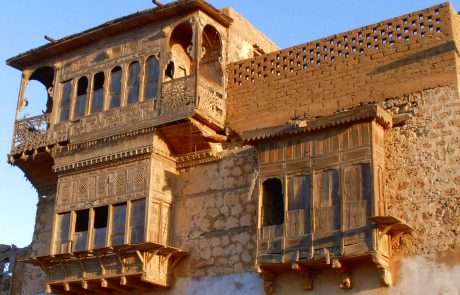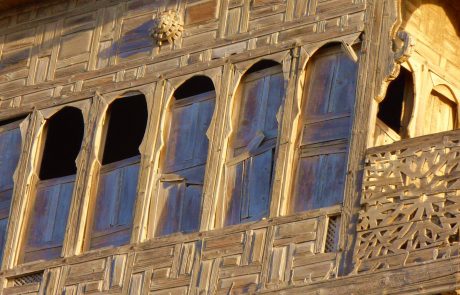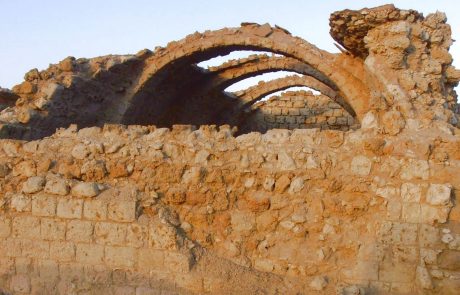August 2018
Yanbu is on the other side of Saudi Arabia from where I lived and worked for five years on the Gulf Coast in Dhahran. I had heard about the city because it’s one of two industrial developments undertaken by the Royal Commission (info here), the other being Jubail, which is within easy striking distance of Dhahran. I’d been to Jeddah a couple times on business but not out into the environs, and I’d travelled by car from Taif (south of Jeddah) all the way down to Khamis Mushait and back (see the post on that trip here). Yanbu lies well north of Jeddah and within the ambit of Medina, which lies only about 160 km away, so that particular corner of Saudi Arabia was outside my ken. A friend from Yanbu extended the invitation to visit whenever I liked, so in January of 2015, some seven months before I left my job in Dhahran and departed from Saudi Arabia never to return, I made my way to Yanbu to have a look with my friend as tour guide.
The start of the trip was not auspicious and we have my fortitude as a traveller to thank for the fact that I made it to the airport and eventually to Yanbu. Less hardy (or more sensible) people may well have turned back. I had left plenty of time to drive from Dhahran to the airport in Dammam — a distance of some 30 km. But as usual when the Travel Gods get wind of the fact that I’m going on a trip, bad things began to happen. By the time I was ready to hit the road toward the airport a full-on sandstorm was underway. 🙁 Those of you who’ve never driven through a sandstorm can imagine driving through a blizzard, only instead of snow you have sand pelting your car and covering the roadway. Oh joy. I’d driven through two other sandstorms so had a few of the tricks for such conditions to the ready — watch the side of the road to see where the pavement leaves off if at all possible, go slow (unlike the Saudis whizzing by you at normal speed LOL), and DON’T use your wipers if you want to be able to see through your windshield in the future. The paint job on your car may take a hit, but hey, you pays your money and you takes your chances. Fortunately the wind was not at hurricane force that day so my 10 year old Mazda suffered no cosmetic disfiguration. I had my work cut out for me navigating my way down the road, however. Once in the vicinity of the airport, the Saudi penchant for minimalist directional signage, nearly always placed exactly where you need to turn rather than before it, joined with the necessity of keeping my eyes peeled on the road to produce two full trips around the airport loop road before I finally spotted the bloody sign and made the turning. Departure time loomed ever closer. Will he make it? Will he end up a raggle-taggle stretch of parched bones uncovered by the next sandstorm as it blows away the deposits of the last one? Not to worry, I finally made it to the airport, parked and got to the gate with about 5 minutes to spare. Close one.
Sandstorms can close airports, of course, but the Travel Gods failed to throw that spanner into the works, as well. So arriving just under the wire to a flight that was not cancelled, not even delayed, I had the perfect opportunity to pat myself on the back for having outsmarted the Travel Gods yet again, those old creeps. Off we went toward Yanbu in a flurry of sand that cleared once we began our climb into the sky where the storms can’t reach. When we landed a couple hours later in Yanbu it was clear as a bell.
Places on the Gulf Coast have little history. The Red Sea was where the action was in the past in Saudi Arabia, in the Hejaz region. Yanbu was in antiquity one of the staging posts on the Incense Route (info here and BBC documentary by Kate Humble here), the trade route that brought frankincense from Oman to the Middle East and made a lot of people very wealthy in the process. The source of wealth today is oil, of course: Saudi black gold. The Wikipedia page on Yanbu (here) has this to say:
Yanbu is an important petroleum shipping terminal and is home to three oil refineries, a plastics facility and several other petrochemical plants. It is the country’s second port (after Jeddah) and serves as the main port for the holy city of Medina, 160 km (99 mi) to the east. The natural harbour is protected on both sides by wide coral reefs. These reefs remain mostly untouched, making them excellent areas for diving. Three major oil pipelines lead across the desert from the oilfields in the east to terminate at the Red Sea in Yanbu.
All that and KFC, too — what more could you want? 🙂 I did want more. I wanted history. I wanted some sense of a life that went on before oil started being pumped out of the ground in the 1930s, because that sense was wholly absent from the part of Saudi Arabia in which I lived. Dhahran is an Arab version of Houston for the most part, if you overlook the mosques. The area of the company compound I lived in could well have been lifted wholesale from Texas and plopped down in Saudi Arabia, so few are the differences from what you’d see in the USA. Yanbu’s twin sister, Jubail, likewise has no history. It’s all brand new, dreamed up as a planned industrial city and wholly devoted to that purpose. There’s a corniche area along the coast with a mall (what else?) but it’s entirely incidental to the industrial goings-on.
Yanbu is quite different. It has industrial development, to be sure, but there was something there before all that business began. There is history in Yanbu, quite a lot of it, in point of fact, if one reads the chronicles. The industrial city began development by royal decree only in 1975. It occupies its own precinct, Yanbu Al-Sina’iya, set off from the historic center of the town that sits in Yanbu Al-Balad. In typical fashion the expats brought in to work in the oil and petrochemical facilities are housed in posh compounds in the industrial city. In the four days I spent in Yanbu I only saw a handlful of white folks in the downtown area where I stayed. It’s inconceivable that a foreign family would live in the historic area. Being the lone whitey most of the time suited me just fine — I’d come to see something authentically Saudi, not more foreign import goods like myself.
My hotel was a bit north of the historic center and its vicinity was fairly new, so there’s little to ooh and aah about there. Soon after settling into my suite, however, my friend and I went to the Corniche, along the shore, and I had my first experience of the Red Sea. I was astonished and delighted. Time for some pics:
Nothing in the historic town gives away the presence of the industrial city to the northeast, which I never saw. The Corniche is purely Saudi, no concessions are made to the expat population. But my excitement stemmed from a different source: the Red Sea itself.
It will only make sense to you if I explain what you experience when you visit the Arabian Gulf (Persian Gulf to some of you fureners, but NEVER use that term in Saudi Arabia unless you want trouble because Persian means Iranian OMG STFU we don’t talk about those lowlifes). Dhahran is adjacent to Al Khobar, which sits on the Arabian Gulf, and you can get down to the water in about 20 minutes. I would do best, I think, to quote Rebecca West from her book Black Lamb and Grey Falcon about her sighting of the Adriatic on terms less than ideal:
” … Valleys that I had seen in summer-time and knew to be rocky deserts strewn with boulders the size of automobiles were level as lakes and swansdown white. I grumbled at it, for I had wanted my husband to see the crocuses that I had seen the year before lying under the trees like dapples of mauve sunshine, and all the red anemonies springing among the lion-coloured stones. I kept on saying, ‘It will be all right when we get to Dalmatia, when we come to the coast.’ But in the early afternoon we caught sight of the Adriatic across barren, snow-streaked hills, and it looked like one of the bleaker Scottish lochs. Sky and islands and sea alike were bruise-coloured.”
There are no streaks of snow on the Gulf coast in Khobar, but looking out over the water could indeed call to mind one of the bleaker Scottish lochs. The Straight of Hormuz chokes the Gulf to within an inch of its life so the water barely circulates. There are barely any waves. The color of the water is a bilious green, for what reason I know not, nor is it a matter of much importance to me. There’s quite good fishing in it to judge from what one finds in the fish market, but ask any local where the best fish in Saudi comes from and the answer will be “the Red Sea.” To put it another way, a visit to the Arabian Gulf is highly unlikely to yield a peak experience.
That goes a good way to explain why I stopped dead in my tracks when I came to the shoreline in Yanbu for the first time. The water is crystal clear and you can see everything on the ocean floor. The light dances on the water in brilliant flashes like it does on the facets of a diamond. The sight was enchanting and I will remember it clearly for the rest of my life. The pics I took can’t hope to do justice to the experience, but they may give some small idea of the sights that gave me a bona fide peak experience:
The day I took those pictures was sunny and pleasant, what in the States we would call perfect summer weather. In January. The period between December and April — late April if luck is with you — brings cool nights and sunny days that warm but do not scorch. Every day I stepped out of my townhouse during those months I thanked my lucky stars, knowing full well that were I back from whence I came I’d be up to my knickers in snow and freezing my backside off. Just another element of the peak experience that day — perfect summer weather and crystal clear water on the seashore in what for my expat self was the dead of winter. I still get weak at the knees thinking about how delicious it was to escape winter entirely and have day after day of sunshine in temperatures that made short sleeves just right.
The trip to Yanbu brought me my first experience of feeling beside the sea in that part of the world. As I said above, the Arabian Gulf communicates no more than the sense of being beside a large lake of no distinguished aspect. Here on the shore at Yanbu, however, there was no doubt that you were in the presence of The Sea. The Sea, not some bleak Scottish loch, thank you very much. No wonder I felt like dancing.
The Arabian Peninsula is extremely minimalist in the botanical department save in the southwest corner, so I harbored no great hopes of seeing anything resembling a tree, and we need not even speak of wildflowers. Being the adaptable fellow I am, however, I was content to dawdle beside the water and enjoy the sea flora and fauna. It was possible to see all the fish swimming about in the water near the shore. None of them looked like they’d serve very well for dinner, but KFC was just down the road, so no biggie. 🙂
That first evening my friend and I went to a shisha place right on the water. Shisha, for the uninitiated, is the Gulf term for what is also called the hookah, the type of water pipe the Caterpillar in Alice in Wonderland puffs while giving Alice a hard time. We sat and puffed and drank mint tea while the evening progressed lazily along and the lights from the shore sparkled on the water. Ah, the Arab life — when it’s good, it’s really good.
A second objective of my trip was to experience the part of the Hijaz mountain range just behind Yanbu. The Hijaz runs like a backbone all the way up the western side of Saudi Arabia. A couple years earlier I had done a long road trip through the southern portion, as I mentioned above, but I knew the look of things was different in the northern end of the range. I wasn’t exactly sure what to expect but was anxious to pay a visit and see for myself. The next day my friend picked me up in the cool of the morning and off we drove into the desert toward the mountains looming on the near horizon.
So that you have a basis for comparison, here are a few pics of the Hijaz range in its southern part, well south of Jeddah, which lies 300 km south of Yanbu:
Mountains like those in the southern Hijaz range scream major tectonic uplift. The rock is granite, as well, which is volcanic in origin, not sedimentary. You’re very near a plate boundary in the Hijaz mountains, on what is conveniently named the Arabian Plate (info here). Here’s the map from the Wikipedia article:

Small wonder the Planet decided it was a good place for a spot of orogeny. With a crowd like that, how could you not throw a party? So up came the Hijaz range. The entire western region of Saudi Arabia is also part of the Arabian Shield, composed largely of pre-Cambrian rock exposed by the tectonic uplift (info from the Saudi Geological Survey here). Yanbu is far enough north, however, to be on the tail end of the major orogeny zone. The mountains between Yanbu and Tabuk are spotty, not the huge granite monoliths of the southern and central Hijaz range. And oh boy do things look different up North. See for yourself:
The pics are in order of approach, from lowest to highest. As usually happens, you start out small and get bigger. Things never reach the monumental proportions of the more southerly Hijaz, but all the same, these are serious mountains. And they’re as bare as a baby’s butt. They’ve had a long time to go bald — much of the rock in the area is what’s known geologically as Precambrian basement (info here), some bits as old as 800 million years. That’s even older than me, jeez … Anyhoo, we’re looking at ancient stuff that’s been around the block more than once. By around the block I mean sucked down and cooked in the upper mantle and then spat up again. Apparently that’s how our mineral friends get their jollies. And who’s to say they should not amuse themselves in those ways? I can’t say the idea appeals to me, but different strokes for different folks, right?
I can’t help seeing landscape like that in the first pic without thinking of Africa. It’s not very far away, and in the western reaches of Saudi you come across black people whose ancestors were brought over as slaves. In Al Baha, south of Jeddah, I stood once behind someone in a fast food joint who could easily have just arrived from the Congo, but he was as Saudi as you please and dressed in thobe and gutra. That kind of ethnic diversity doesn’t exist in the Eastern Province where I lived. There’s it’s all about whether you’re Sunni or Shia, not about whether you’re tan or black. I suspect the Africans, had they been sent as slaves to the wastes of the eastern desert, would have jumped into the Gulf to swim back to Africa if that was the only way out. They would thereby have shown themselves to be eminently sensible folk, too, no doubt about it.
Look carefully at the last pic in the first row and tell me if you see a resemblance to anything. Hmmm … what could it be? … Surely I can’t be the only one who sees an elephant head in that rock formation. Right? Right?? It jumped out at me as soon as I saw it. But if you don’t see it then fine, never mind, I’ll just take it as another sign of my superior perceptive abilities. 🙂
As you move further into the range things start getting more vertical fairly quickly. The rock formations at lower elevation resemble nothing I saw in the southern part of the Hijaz range. The tectonics in the Yanbu area were apparently a bit different, since it lies directly on a geologic suture. The formations below the high mountains are what I would call lunar — jumbles of granite piled willy-nilly in a wilderness of shapes like you see in the first picture of the bottom row. It’s a landscape that seems to have remained for eons impervious to the effects of wind and water, taking its shape from the movement of the ancient Earth itself and staying exactly where it was put when the geologic brouhaha stopped. I can report that such a landscape makes for very poor walking, unless you’re part goat. I’m not, unfortunately … yet another of my numerous failings. They do mount up, I quite realize, no need to rub it in …
The last two pics in the bottom row are of the area of Mt. Radhwa, I believe. I’ve done the best I can to verify that assumption and even so voice it hesitantly with the proviso “don’t quote me on that.” But it pleases me to think I’m correct, and a girl’s gotta take her fun where she can get it. Whatever the name of the mountains, they’re impressive and so wholly un-user-friendly I was very glad indeed as I soaked up the sights to be standing beside a car ready to take me back to my hotel. I’d love to see what Bear Grylls would do with that barren environment as his survival palette. Drinking his own effluvia (apparently one of his aces in the hole) would be about the only way to get any liquid, that’s for sure. Ooh, tooo organic … let’s contemplate the peaks for a moment and then head back into town, shall we? We’re just tourists, after all. 🙂
When the next day dawned the historic bits of town were on the sightseeing agenda. Without further ado let’s move to the photographic evidence:
It’s important to understand that in Saudi Arabia “historic” doesn’t necessarily mean “conserved” or even “protected.” The historic center of Yanbu makes that situation quite clear. Mind you, there’s plenty of history, enough to make quite a good open-air museum of things if the spirit moved and the flesh were not weak. But apparently the flesh is falling off the bone, as an article (here) in the Arab News from 2010 makes evident:
The most recent was a house in the historical part of the city that fell down in front of a group that was set up to save the city’s heritage.
The SCTA and the Technical and Vocational Training Corporation (TVTC) signed an agreement last May to train people to maintain and preserve old houses that could then be converted into tourist spots and generate jobs.
Awwad Al-Subhi, chairman of the heritage committee, said it was regretful that houses continue to fall despite the SCTA and TVTC agreement. He recalled that a few days ago he passed through the historical Al-Sour area of Yanbu and noticed that several buildings had collapsed there.
Al-Subhi said it is not expensive to repair and maintain old houses.
“A few thousand riyals are enough to keep the houses for coming generations who should see how their ancestors lived,” he said, adding that he is confident that if the program — called “It Should Not Fall” — is carried out, members of the public would become more aware of the need to preserve the region’s history.
One of the houses in the historic district even accommodated that stuff of legend Lawrence of Arabia — aka T.E. Lawrence, now of rather dappled fame after all that has come to light and all the revisionist assessments of academia in the service of political correctness and anti-colonialism stemming from 20/20 hindsight. Yes, he was there, but his house is falling to bits, as an article from the Saudi Gazette entitled “Lawrence of Arabia’s House in Yanbu Struggles for Survival” (here) explains:
ONE hundred years have passed since Lawrence of Arabia last stayed there. Despite an expected visit by Prince Sultan Bin Salman, president of the Saudi Commission for Tourism and National Heritage, the historic residence in Yanbu is struggling for survival.
The neglected building has been the focus of a debate for some time now, with historians urging the authorities to restore the house and make it accessible to visitors.
British intelligence officer Thomas Edward Lawrence, better known as Lawrence of Arabia, lived in the old town of Yanbu between 1915 and 1916.
The pics attest to the difficulty of coordinating restoration, conservation, preservation, anything that would save historical buildings from decay and disappearance. I feel fortunate to have seen the house with the lovely woodwork, since it’s likely the only one of its kind that will survive during my lifetime. The basic problem is that Saudis have no interest in things historical. They pay ample lip service to them, but when it comes to putting your money where your mouth is, the money is much more likely to go to some bling-fraught new construction than to the care and preservation of historical structures. Given the fragmented nature of the population, bound to its tribal roots as it is, the success of efforts to save a particular building in a particular locale depends largely on the clout the political figures from that area carry at the national level. Yanbu may be under the administration of the Royal Commission, but the Commission isn’t interested in historical buildings, it’s interested in petrochemical plants and oil refineries. I’m glad I had the opportunity to see the historical buildings that still show something of the area’s cultural past — it’s a lovely heritage fully worthy of careful preservation. One suspects — may history prove me wrong — that the buildings still relatively in one piece will end up in the state of the structure in the last picture, which is also “historical,” at least what’s left of it. One wonders what covered the ribs of that barrel vault …
The last day before my flight in the late afternoon I spent by the Red Sea, still enchanted by the clarity of the water and the sunlight on its surface. It was a brief visit, but I feel in those few days I managed to absorb something of the feeling tone of the place, something of its long history, and I came quickly to appreciate the juxtaposition of clear water and naked stone. They go well together. The Planet knows how to throw a great party, no doubt about it.



